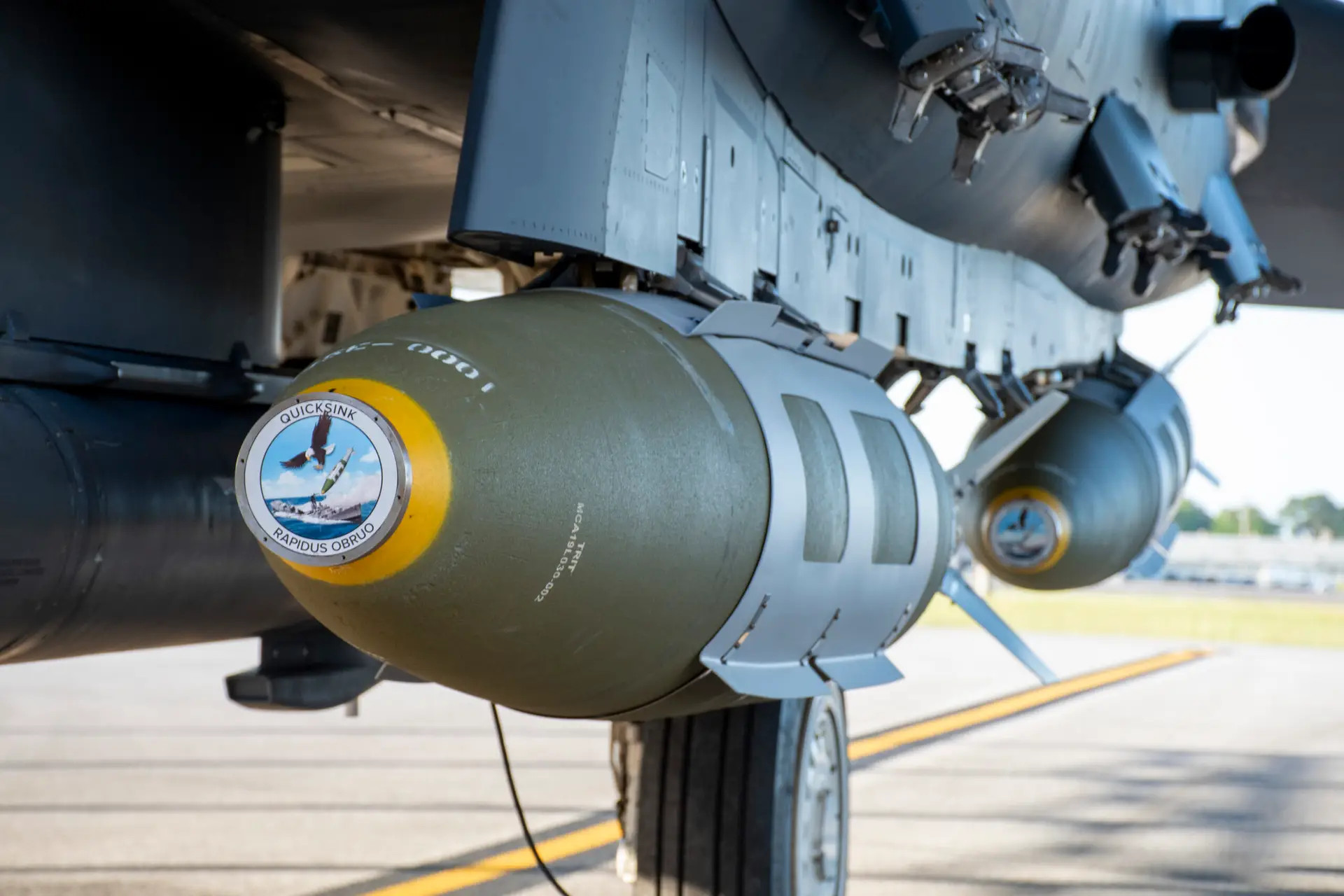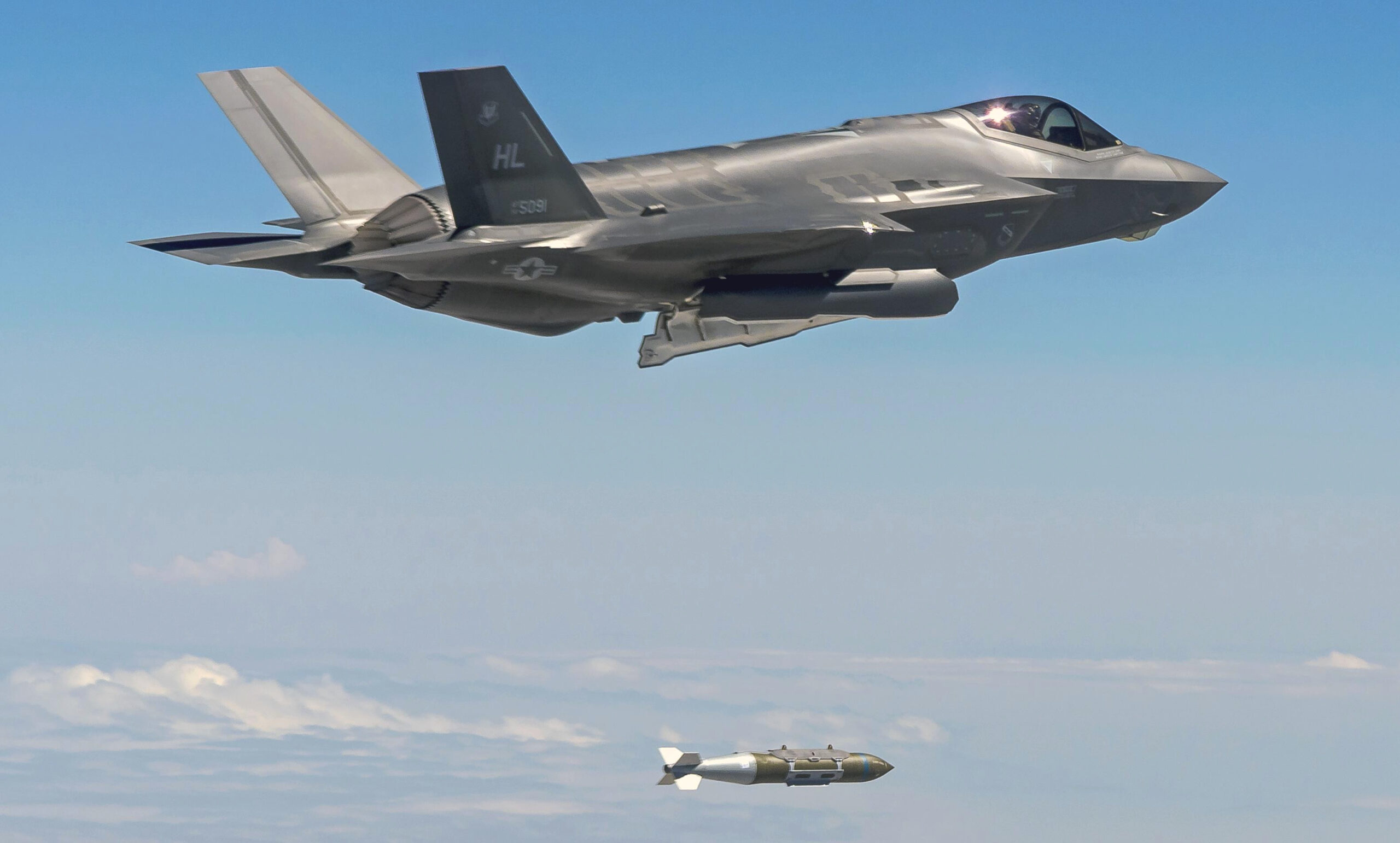The U.S. Air Force has put out new video footage from a test earlier this year of a modified 2,000-pound class GBU-31 Joint Direct Attack Munition, or JDAM, optimized for use as an anti-ship weapon as part of program called Quicksink. The clips, interspersed in the full video below, provide additional views of the bomb’s impact from the deck of the target ship Coastal Sea, which was split in half as a result.

The Air Force Research Laboratory (AFRL) first showed this updated video footage, which also included 3D imaging of the two halves of Coastal Sea resting on the bottom of the Gulf of Mexico, where they now form an artificial reef, at the Air & Space Forces Association’s 2022 Air, Space, and Cyber Conference. AFRL also displayed a 3D printed mockup of the Quicksink seeker head, the first public look at this component of the weapon, at the conference’s technology exhibition. Representatives of the laboratory provided additional details about the seeker, including about its cost, and other aspects of the bomb on the exhibition on the floor.

AFRL has now confirmed that the Quicksink seeker, the model of which is seen below, is a dual-mode system that combines a radar seeker with an imaging infrared (IIR) camera, as The War Zone has postulated since this program was publicly announced last year would all but certainly be the case. The radar seeker is contained in the front portion of the nose while the camera is installed in a fairing on the side. This is all then integrated onto the front of an otherwise standard GBU-31/B JDAM, which retains its GPS-assisted inertial navigation system (INS) guidance package in the tail.

The combination of the new multi-mode seeker and the JDAM tail kit turns the bomb into an all-weather anti-ship weapon. When employed, the weapon uses the tail kit to first glide to the general target area, using coordinates inputted prior to launch from the launch aircraft via onboard sensors or from an off-board sensing platform. Once it approaches the target area, the weapon then shifts to the Quicksink seeker to locate the target ship and determine its speed and heading. The use of an independent seeker system means that weapon could potentially still lock onto the target if it appears within the envelope of the radar and IIR camera, even in a GPS-degraded environment that imposes limits on the initial cueing.
Regardless, the weapon then course corrects onto a trajectory where it hits the water and then detonates near the hull below the waterline. This ‘heaves’ the ship, breaking it in two or causing otherwise massive damage. Even a near miss would likely result in a ‘mission kill’ where the ship’s systems are disabled to the point that it is no longer combat effective.

The stated core goal of the Quicksink project is to provide a low-cost air-delivered weapon that offers capabilities that are similar, at least on some level, to a heavyweight ship or submarine-launched torpedo. Heavyweight torpedoes, like the U.S.-made Mk 48, are designed to sink even very large warships by detonating underneath them and breaking their hulls.

The Mk 48 is unquestionably the most devastating conventional anti-ship weapon in the U.S. military’s present inventory, but the flexibility to employ it is limited by the fact that it can only be launched, at least presently, by U.S. Navy submarines. Those submarines, of course, cannot be everywhere at once. “Quicksink is an answer to the need to quickly neutralize menacing maritime threats over vast areas around the world,” AFRL’s website says.
The video below of the sinking of the ex-USS Ingraham, a decommissioned Oliver Hazard Perry class frigate, during an exercise in 2021 ends with a clip of the ship being finished off by a Mk 48.

There is also the matter of cost. In its most recent budget request, for the 2023 Fiscal Year, the Navy asked for just over $151 million to buy 28 examples of the latest Mk 48 Mod 7 torpedo, for an average unit cost of just under $5.4 million. Unit costs certainly do fluctuate regularly, particularly as a result of the total size of an order, but a review of prior Navy budget data shows that the Mk 48 Mod 7 is firmly a multi-million dollar weapon.
AFRL says that right now, the Quicksink seeker kits, which can be readily integrated onto existing GBU-31/Bs as required, each cost around $200,000. This could drop considerably if production increases, with laboratory representatives at the Air, Space, and Cyber Conference telling The War Zone that they hoping to see an average unit cost of closer to $50,000 after 1,000 examples have been made. Even when combined with the costs of acquiring the underlying 2,000-pound class bombs and the JDAM kits, a complete Quicksink weapon promises to be substantially cheaper than most anti-ship missiles, which generally all have price points of $1 million or more.
One of the ways AFRL says that it has been working to keep the seeker’s cost down is by avoiding the need for a more detailed database of representative ship profiles, as are typically used in combination with IIR guidance systems on many anti-ship missiles. The Quicksink seeker is designed to spot and lock onto the target ship based only on its length.

This could of course raise concerns about just how robust the seeker is, and about the risks of it zeroing in on the wrong target, especially in a more congested maritime environment. There seems to be a firm belief on the Air Force’s part that very detailed length data, plus the initial target identification and cueing that the weapon requires, will mitigate any such issues.
The Quicksink seeker is also built around a highly modular, plug-and-play architecture that is designed to help reduce costs. This could make it easier to add new and improved functionality to the system in the future. The seeker, or components thereof, could potentially be utilized on other weapon systems, as well.
It is also important to note that the Air Force has not presented Quicksink, whatever its ultimate capabilities might be in terms of guidance and lethality, as any kind of replacement for heavyweight torpedoes or other anti-ship weapons. The idea is to create a new additional low-cost, flexible anti-ship tool that can be readily carried by a wide array of existing tactical jets, including stealthy F-35A Joint Strike Fighters, as well as bombers and potentially other aircraft.

The added volume of affordable, but capable anti-ship capacity that Quicksink might offer could be very valuable, particularly in any future maritime-centric high-end conflict across the broad expanses of the Pacific, such as one involving China. The Chinese People’s Liberation Army Navy (PLAN) has been working to significantly expand the total size of fleets, especially when it comes to larger, more capable warships, including a growing number of aircraft carriers, and continues to do so.
It is worth pointing out that the JDAM has a range of around 15 miles, depending on the altitude at which it is released, so it has only limited stand-off capability. This could make the Quicksink derivative more complicated to employ, even from a stealthy platform, in certain higher-risk scenarios. At the same time, Quicksink bombs could be used against lower-risk targets, including logistics and support vessels that would still be important to neutralize, freeing up longer-range and otherwise more capable munitions for prosecuting higher-end threats. There are available wing kits that extend the range of JDAMs that could be used on Quicksink bombs, too.
Altogether, if the Quicksink seeker proves to be sufficiently robust and reliable, as well as relatively cheap, it could prove to be a very attractive way to expand the U.S. military’s arsenal of ship-killing capabilities, and do so quickly by leveraging existing stocks of munitions.
Contact the author: joe@thedrive.com
